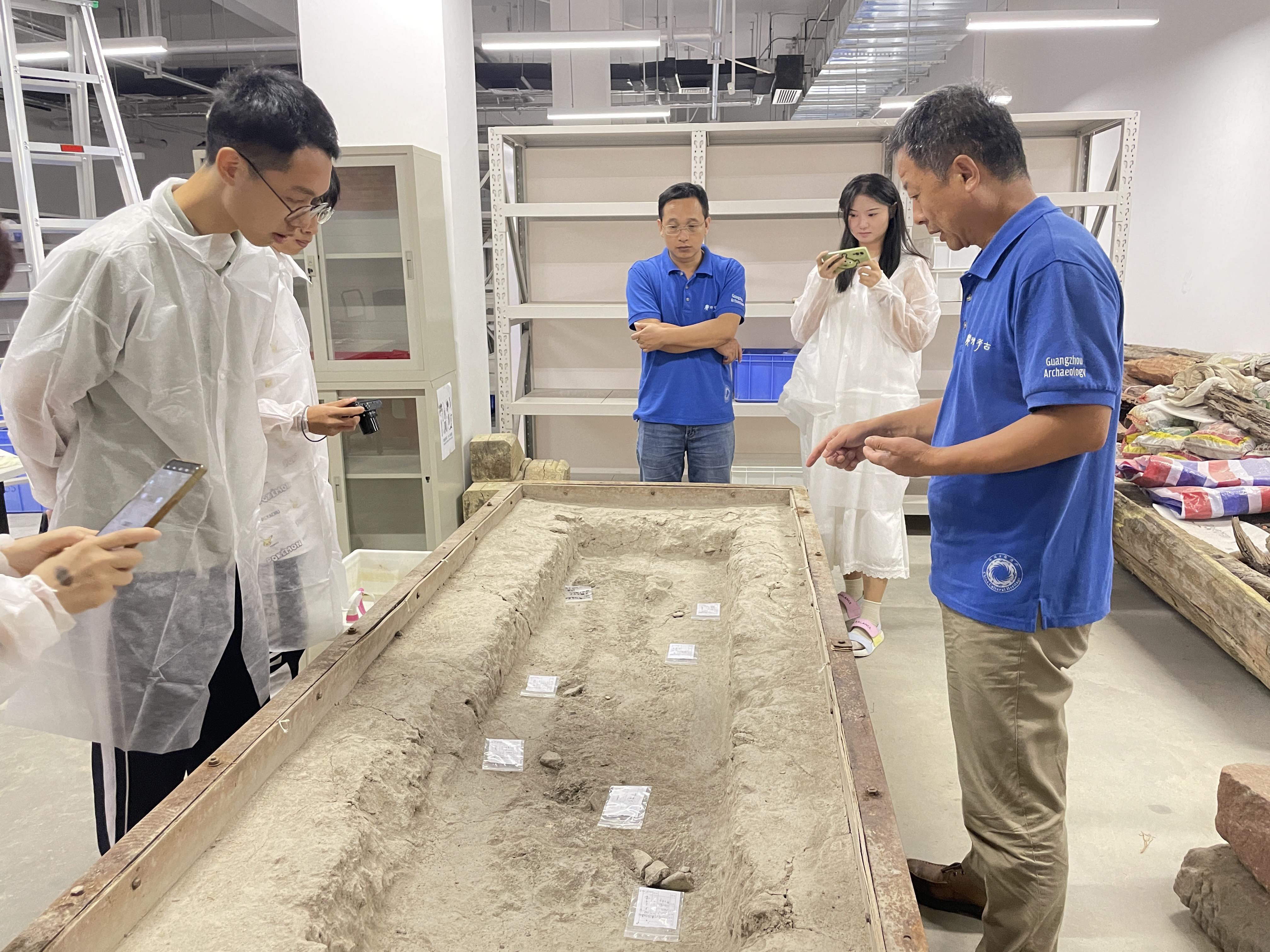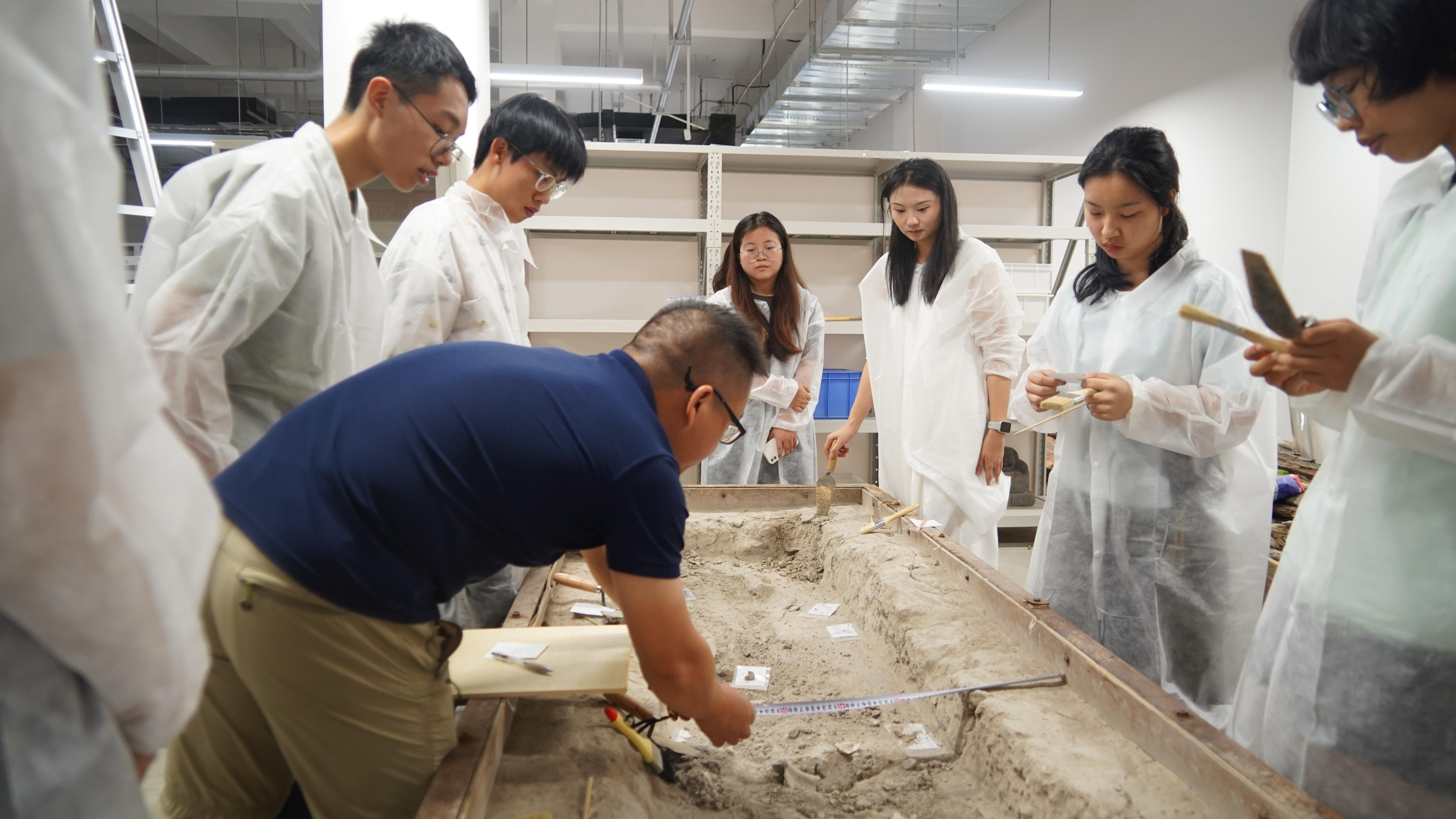
On the morning of July 4th, the archaeology lab at the Museum of Two Mausoleums of Southern Han State welcomed some special "staff"—five prospective university students who recently completed their college entrance exams. Under the guidance of professional archaeologists, these students embarked on an exciting and educational experience in the lab at the Nansha Lujing site in Guangzhou, Guangdong province.

At the museum's public archaeology activity center, Huang Bixiong, the study tour instructor from the Guangzhou Municipal Institute of Cultural Heritage and Archaeology introduced the basics of archaeology to students: its definition, the process of excavations, and the importance of lab archaeology. With foundational knowledge, the students eagerly followed Huang to the lab.
Zhang Qianglu, director of the Guangzhou Municipal Institute of Cultural Heritage and Archaeology, who once led the excavation of the Nansha Lujiang site, provided an overview. The site from the pre-Qin period (before 221 B.C.), which dates back 4,500 to 3,500 years, spans the late Neolithic Age to the Shang Dynasty (1600-1046 B.C.). The No. 1 tomb at the site is one of the latest relic units from this period, over 3,500 years old, marking Guangzhou's first discovery of a human tomb from over three millennia ago.
"These primary deposits require further archaeological excavation. Your task today is to clean this tomb layer by layer and carefully extract the pottery shards and other artifacts," Zhang explained. When he introduced the basic operation specifications, the five students were eager to begin.
They suited up in uniform work clothes and selected their excavation tools. They were surrounded by the wooden case, and they started to excavate one visible piece. However, the excavation was not smooth. The tomb had been stored in a warehouse for years, and the soil had become very hard as the moisture evaporated.
Under Huang's guidance, the students switched from bamboo sticks to sturdier tools like trowels and scrapers and used water to soften the soil, gradually making progress.
Bones, pottery shards, shells—artifact after artifact was successfully unearthed by the students. They then photographed the artifacts with professional cameras, filled out labels with detailed information, and bagged each item. Therefore, each artifact had its own "ID card".

Observing, excavating, cleaning, photographing, recording, and extracting—following the strict archaeological procedures, the students were thoroughly engaged in their tasks.
Xi Yepeng, from Shenzhen High School of Science, shared his enthusiasm. He loves visiting museums and has developed an interest in archaeology and history. He traveled from Shenzhen by high-speed train early that morning to participate in the event.
"It's a rare opportunity to get firsthand experience in an archaeological setting, so I really wanted to try it out. I applied for the history undergraduate program at Sun Yat-sen University for the 2024 admissions, still awaiting the results. This event also gave me a chance to experience the work environment in the museum," Xi said.
Source :Yangcheng Evening News
夏日研学进行时,五名“准大学生”在博物馆实验室考古发现了什么?
7月4日上午,南汉二陵博物馆的考古实验室迎来了几位特别的“工作人员”,他们是今年刚刚参加完高考的五名“准大学生”。在专业考古工作者的带领下,五名学生将参与到广州南沙鹿颈遗址的实验室考古工作中,由此开启一次有趣又有料的人生考古初体验。
在博物馆的公众考古活动中心,研学导师、广州市文物考古研究院考古研究部黄碧雄首先给五名学生介绍了“考古是什么”“考古发掘怎么做”“我们为什么要做实验室考古”等内容。有了基本的理论知识储备,五名学生满怀期待地跟随黄碧雄前往实验室。
广州市文物考古研究院院长张强禄曾负责南沙鹿颈遗址的发掘工作,他介绍,该遗址自2001年底开始发掘,是距今约4500~3500年的新石器时代晚期至商时期先秦遗址。其中,南沙鹿颈遗址一号墓应为遗址早期遗存中最晚的一个遗迹单位,距今3500多年,是广州首次考古发现三千年以前的人类墓穴。
“这些原生堆积需要作进一步的考古发掘。今天你们的任务就是按照地层的早晚关系,从上到下去清理这座墓葬,并将这些陶器碎片等科学提取出来。”在张强禄讲解完基本的操作规范时,五名学生已经跃跃欲试。
穿上统一的工作服,选择合适的发掘工具,五名学生围站在木箱四周,各自开始一处可见物的发掘。然而,由于这座墓葬已经被存放在库房多年,土壤中的水分早已蒸发殆尽,土质也变得十分坚硬。这让学生们一开始的发掘并不顺利。
在黄碧雄的指导下,他们将手中的竹签换成了手铲、刮铲等更为坚硬的工具,并用水壶不断朝发掘处喷水润湿。由此,他们的发掘也渐入佳境。
碎骨、陶片、贝类……一件件遗物经由五名学生之手成功发掘出土。紧接着,他们又用专业相机为出土物拍照,在标签纸上填好出土物的各类信息,然后将其与出土物一起装袋。这样每件出土物就有了自己的“身份证”。
观察、发掘、清理、拍照、记录、提取……遵照严格的考古发掘流程,五名学生忙得不亦乐乎。
来自深圳科学高中的奚业朋告诉记者,日常生活里他很喜欢逛博物馆,因此对考古和历史有了兴趣,当天一早他就从深圳坐高铁前来参加这次活动。
“获得走进考古现场的机会是非常难得的,所以特别想来体验一下。在中山大学2024年自主招生中,我报考了历史学专业,现在还在等待结果中。参加这次活动也是借机来感受博物馆的工作氛围。”奚业朋说。
文、图 | 记者 文艺 通讯员 粤文旅宣 (除署名外)
翻译 | 赵凡
-
Sipping tea, listening to music: Traditional live houses in old Canton
2024-07-06 13:15:54 -
Poster | Experiencing the Shenzhen-Zhongshan Link makes the one-hour tourism circle of the GBA a hotspot
2024-07-05 20:51:36 -
Seaside counties emerging as popular summer destinations
2024-07-05 19:54:22 -
Romantic summer: discover Guangzhou's 'Monet Garden'
2024-07-05 19:43:03






